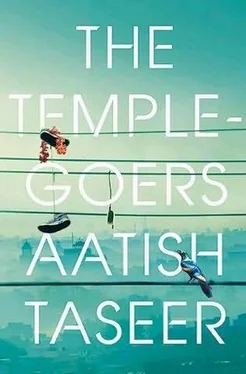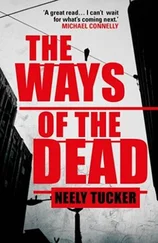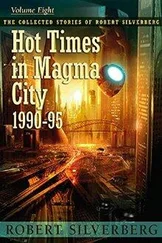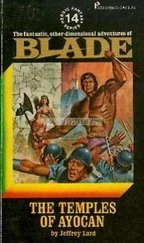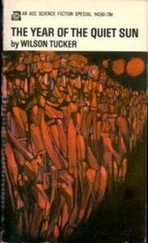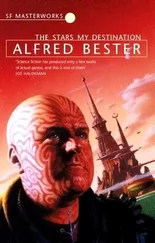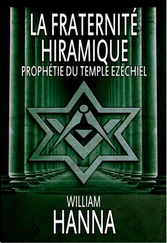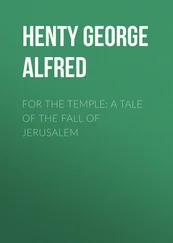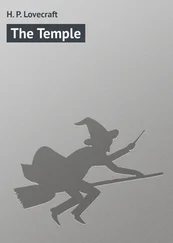‘What is nice,’ the writer said, ‘is the absolute confidence in the faces. These people are…’
‘Complete,’ his wife finished for him.
‘Yes, yes.’ Then rising, he said, ‘We won’t look at everything or we’ll get tired; only at the fine things.’
We walked into the museum’s main rooms past long pieces of carved stone.
‘Lintels,’ the writer said, pointing with his shooting stick. ‘We didn’t have the arch; we had lintels.’
We entered a circular passage with a grubby marble floor. On one side, past glass walls, was an open courtyard with a stone chariot in the middle. On our right was a red-painted sign for the bronzes. I was wondering when the building that housed the collection had been built and asked the writer about it.
He misunderstood my question or chose to answer it differently. ‘I’ll tell you, I’ll tell you,’ he said, as we entered a room with chalky-green walls. ‘These bronzes used to be in the viceroy’s house. They were collected by the Archaeological Survey of India. A British institution. It is safe to say that not a single Indian prince made a collection like the one we see displayed here, though he easily could have. The Maharaja of Patiala went to England, where he had his portrait painted, that was the thing to do, and he picked up a few nudes and brought them back. They gloried in their ignorance,’ the writer said, ‘gloried in their ignorance.’
The room we entered was in spotlight and shadow. And though in places a crucial light was fused, a pink bucket left in a corner, the glasses of the display cases fingerprinted and dusty, there was something entrancing about the green, dimly lit room with the bronzes and the shadows they cast.
The writer, as if wishing to give me the best of his energies, wanted to see the Natraj first. On our way to it, he stopped in front of an unfinished Chola Natraj. He looked for Shiva’s drum, but it wasn’t there. Next to the bronze was a black and white picture of an artisan working on the floor, illustrating how the object was made. The writer, as if anticipating a buried judgement in me, said, ‘That man seeming to hammer out the image would have had all kinds of fine ideas going through his smooth head.’
Then following my eyes drift to the Natraj, he considered Shiva’s dance of creation and destruction. He said it was very close to him; he described it as having entered his soul, this idea of the nearness of creation and decay. ‘How did that idea, the twin forces of creation and decay,’ he asked, as we approached the bronze Natraj, with its floating hair, and one leg filled with the tension of both rising and swinging, ‘become enshrined in human form?’
‘I don’t know, I don’t know,’ he said, answering his own question. ‘I don’t think anyone knows. I think the thing just appeared like Venus rolling in from the sea in Cyprus in rock form. It was created wholly by the imagination of men.’
The Natraj had been turned into a national icon in India, appearing in airports and on HB pencils; the writer knew this.
‘The image,’ he said, ‘is much debased. It’s used everywhere, like some of the Leonardo da Vinci drawings.’ Then looking at the little man, gasping for his life, on whom the dancing Shiva stood, the writer said, ‘I will interpret it in my own way. He is standing on the monster of ignorance.’ That monster the writer saw as representing ‘the snare of life’. He didn’t mean appetite, but irrationality, darkness and cruelty especially; the possibility men always have of being less than men.
Standing before this most Indian of Indian images, the writer could not have been oblivious to its context. He was a man who always knew where he was. He seemed to stand there considering the dark history that had landed the bronze image before him in a glass case, unseen, unthought of, in the country from where it came. He began to draw a historical thread. But even before he began, I had been thinking of Aakash. I don’t know why; perhaps only because of his feeling for the gods, and my removal. The writer spoke directly to my thoughts.
‘Many people don’t know,’ he said, ‘that in the nineteenth century there was an anti-Brahmin movement and that the Brahmins were driven out of town. That was when there was a looting of their works of art and devotion. The people who were doing the looting didn’t think what they would replace these images with. It was then that they began to appear in the salerooms of Europe and America.’
A nineteenth-century anti-Brahmin movement! Had that been the history behind the magical story of Aakash’s ancestor? Had his run-in with the village, and his subsequent disappearance, ‘the driving out of town’, been part of a larger story, part of an anti-Brahmin movement that the writer, living thousands of miles away, could have read about? Was the statue I had seen of Aakash’s ancestor, with his saffron robes and three streaks of turmeric across the forehead, a gesture of historical remembrance? It was amazing to consider.
The Natraj had been rubbed to shine in some places. The writer liked that. ‘It’s to me a nice idea, rubbing the parts they thought beautiful. No polish…’ he began.
‘Is as good as the human hand,’ his wife finished for him.
We moved on from the Natraj and the writer’s mood lightened. His earlier solemnity lifted, he spoke more generally about the figures. ‘Someone asked me,’ he said, ‘why the figure had four hands. “It’s not a human figure,” I told him. “It’s a human figure representing something. The arms are there to represent what is being honoured.” ’ But when we came to a Shiva in a relaxed human posture with Parvati by his side, the writer chuckled. ‘Here, when the figure has a consort and comes down from its pedestal, things become a little more complicated.’
In another glass case, there were Vijaynagar bronzes. The figures were squatter, thicker of limb. ‘We were talking of security earlier,’ the writer began, and speaking of the Muslim invaders and Vijaynagar respectively, said, ‘They destroyed it and destroyed it completely. This destruction is made beautiful by the Left. You know, by the drawing-room intellectuals, the ladies with their fashionable grey hair and ethnic saris, ambassadors of the Caliph to the Republic of Letters. They say that it was destroyed by the Indians themselves. They are so completely degraded, they can’t deal with their own defeat, but we mustn’t let that spoil the beauty of what we’re seeing.’
The writer began to get tired. We sat down, his wife and I on a bench, him on his shooting stick, with its Air India tag still hanging from it. He began advising me on books I might read about the bronzes. They were all by German and British writers. ‘It’s cause for shame,’ he said, ‘that Indians don’t write these books themselves.
‘You see, the English-speaking people of India don’t come here. They think this is local stuff. They want to go to America and have their self-portrait painted and buy nudes, like the Maharaja of Patiala. And then they complain that the British looted them. These were in the viceroy’s house. It was Nehru’s idea to bring them here; it was a good idea, but no one wants to come.’ He raised his hands, open-palmed, in despair.
The mood excited a story of Coomaraswamy, the Sri Lankan art critic. ‘His dates are 1877-1947. He was half Sinhalese and rich,’ the writer said. ‘It was open to him to start up life as a Mayfair gentleman or in the country, but he decided to devote himself to Indian art. In 1917, when Coomaraswamy was forty,’ the writer added, calculating fast, ‘he heard that the Hindu University was being built in Benares. He offered them his, by then, vast collection of Indian art, which he was ready to give them free on the condition they started a chair of Indian art and made him the professor.’ The writer paused.
Читать дальше
